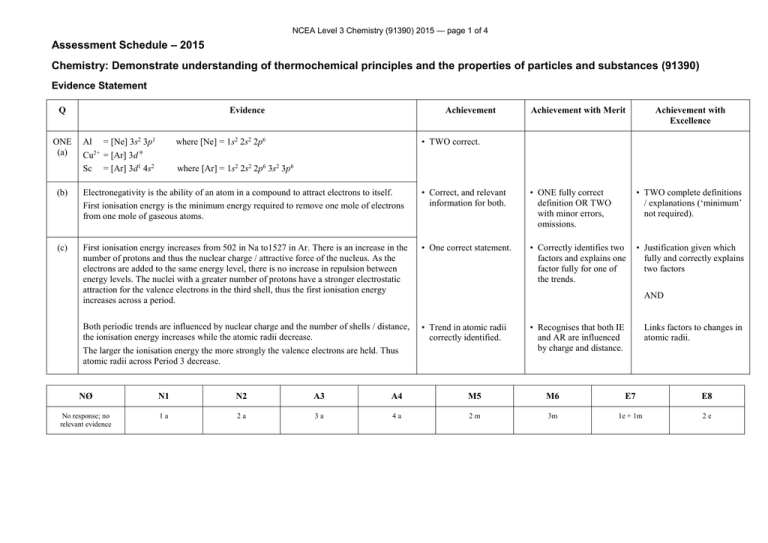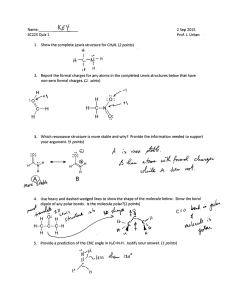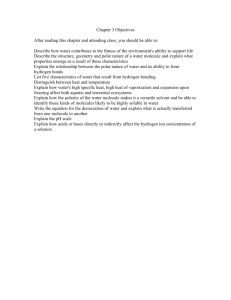– 2015 Assessment Schedule
advertisement

NCEA Level 3 Chemistry (91390) 2015 — page 1 of 4 Assessment Schedule – 2015 Chemistry: Demonstrate understanding of thermochemical principles and the properties of particles and substances (91390) Evidence Statement Q ONE (a) Evidence Al = [Ne] 3s2 3p1 Cu2+ = [Ar] 3d 9 Sc = [Ar] 3d1 4s2 Achievement Achievement with Merit Achievement with Excellence • TWO correct. where [Ne] = 1s2 2s2 2p6 where [Ar] = 1s2 2s2 2p6 3s2 3p6 (b) Electronegativity is the ability of an atom in a compound to attract electrons to itself. First ionisation energy is the minimum energy required to remove one mole of electrons from one mole of gaseous atoms. • Correct, and relevant information for both. • ONE fully correct definition OR TWO with minor errors, omissions. • TWO complete definitions / explanations (‘minimum’ not required). (c) First ionisation energy increases from 502 in Na to1527 in Ar. There is an increase in the number of protons and thus the nuclear charge / attractive force of the nucleus. As the electrons are added to the same energy level, there is no increase in repulsion between energy levels. The nuclei with a greater number of protons have a stronger electrostatic attraction for the valence electrons in the third shell, thus the first ionisation energy increases across a period. • One correct statement. • Correctly identifies two factors and explains one factor fully for one of the trends. • Justification given which fully and correctly explains two factors Both periodic trends are influenced by nuclear charge and the number of shells / distance, the ionisation energy increases while the atomic radii decrease. The larger the ionisation energy the more strongly the valence electrons are held. Thus atomic radii across Period 3 decrease. • Trend in atomic radii correctly identified. AND • Recognises that both IE and AR are influenced by charge and distance. Links factors to changes in atomic radii. NØ N1 N2 A3 A4 M5 M6 E7 E8 No response; no relevant evidence 1a 2a 3a 4a 2m 3m 1e + 1m 2e NCEA Level 3 Chemistry (91390) 2015 — page 2 of 4 Q TWO (a)(i) (ii) (b)(i) (ii) (c) Evidence Achievement H2(g) + ½O2(g) H2O() • Correct equation including states. The equation for the combustion of hydrogen is the same as the equation for the heat of formation of water. • Correct explanation. The fH° (H2O(g)) will be less negative than fH° (H2O()). Making bonds releases energy. As less bonding is present in water as a gas than a liquid then less energy will be released when gaseous water is formed thus the fH° (H2O(g)) will be less negative. • Less negative. 3H2O() + B2O3(s) B2H6(g) + 3O2(g) • Correct process. = + 2148 kJ mol–1 2B(s) + 1½O2(g) B2O3(g) = − 1255 kJ mol 3H2(g) + 1½O2(g) 3H2O() = – 858 kJ mol–1 2B(s) + 3H2(g) B2H6(g) = • Correct statement. –1 Achievement with Merit Achievement with Excellence • Less negative with a correct statement referring to bonds or energy in both states. • Justification linking attractive forces between particles to the change of state and difference in energy. • Correct answer with incorrect units or -35 with correct units. • Correct answer with correct units and sign. + 35 kJ mol–1 NØ N1 N2 A3 A4 M5 M6 E7 E8 No response; no relevant evidence 1a 2a 3a 4a 1m + 3a 2m 1e + 1m 2e NCEA Level 3 Chemistry (91390) 2015 — page 3 of 4 Q Evidence Trigonal bipyramidal (c)(i) (ii) Achievement with Merit Achievement with Excellence • ONE correct shape. • ONE Lewis diagram. THREE (a) (b) Achievement Octahedral XeO2F2 is polar. It has 5 areas of electron density around the central Xe atom, one of which is a lone pair. Maximum separation for minimum repulsion means that the shape is based on a trigonal bipyramid structure, but is actually see-saw. The Xe=O bonds are polar, due to the greater electronegativity of O, and the Xe-F bonds even more polar, due to the F atom having the highest electronegativity on the periodic table. The molecule is not symmetrical, and so the dipole moments cannot cancel, making the molecule polar. GeH4 is non-polar. It has 4 areas of electron density around the central Ge atom, all of which are bonded. Maximum separation for minimum repulsion means that the shape is tetrahedral. This is a symmetrical structure, thus the bond dipole moments cancel, and therefore the molecule is non-polar. • Recognises XeO2F2 is polar and GeH4 is non-polar. • One molecule correctly and completely explained. OR Both molecules partially explained. • Polarities and shapes of both molecules are correctly compared and contrasted. • hydrogen bonding • permanent dipoles • instantaneous dipoles. The attractive forces due to the hydrogen bonding and permanent dipoles are similar between the molecules in both liquids, as they both have one OH group, which causes the molecule to be polar and take part in hydrogen bonding. The two molecules have the same mass, and so the same number of electrons involved in the weak instantaneous dipoles. However, the pentan-1-ol molecule has no side chains and so the main chains can get closer to each other (less steric hindrance, greater surface area), thus the instantaneous dipoles are stronger / greater in pentan-1-ol, and therefore the boiling point is higher. • Lists two forces. • Explains correctly how two factors influence the boiling point. • Explains fully and correctly how three factors influence boiling point. FORCES • Two correct statements related to the forces of attraction between compounds. NCEA Level 3 Chemistry (91390) 2015 — page 4 of 4 (d) ΔcH° = ΣΔfH° (products) – ΣΔfH° (reactants) • Correct process. = [(5 –394) + (6 –286)] – [–295] = –3686 + 295 = −3391 kJ mol–1 • Correct answer with units. NØ N1 N2 A3 A4 M5 M6 E7 E8 No response; no relevant evidence 1a 2a 3a 4a 2m 3m 2e 2e and m Cut Scores Not Achieved Achievement Achievement with Merit Achievement with Excellence 0–7 8 – 13 14 – 18 19 – 24



